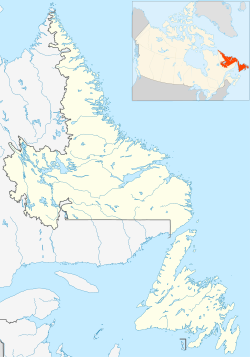Labrador City | |
|---|---|
Town | |
 | |
| Motto(s): | |
Location of Labrador City in Labrador | |
| Coordinates: 52°57′N66°55′W / 52.950°N 66.917°W | |
| Country | |
| Province | |
| Census division | 10 |
| Settled | 1960s |
| Government | |
| • Type | Labrador City Town Council |
| • Mayor | Jordan Brown [1] |
| • MHA | Vacant |
| • MP | Philip Earle |
| Area | |
• Total | 38.83 km2 (14.99 sq mi) |
| Elevation | 555 m (1,821 ft) |
| Population (2021 census) [2] | |
• Total | 7,412 |
| • Density | 186/km2 (480/sq mi) |
| Time zone | UTC-4 (AST) |
| • Summer (DST) | UTC-3 (Atlantic Daylight Saving Time) |
| Postal code span | |
| Area code | 709 |
| Highways | |
| Website | www |
Labrador City is a town in western Labrador (part of the Canadian province of Newfoundland and Labrador), near the Quebec border. [3] With a population of 7,412 as of 2021, it is the second-largest population centre in Labrador, behind Happy Valley-Goose Bay. Neighbouring Labrador City is Wabush, a smaller town with a population of approximately 1,964 as of 2021. [4] Together, the "twin towns" are known as Labrador West.
Contents
- Government
- Economy
- Demographics
- Attractions
- Climate
- See also
- Notable residents
- References
- External links
In the 1960s, Labrador City was founded to accommodate employees of the Iron Ore Company of Canada; iron ore mining continues to be the primary industry in the town.
The Labrador City town motto is Kamistiatusset, a Naskapi word meaning "land of the hard-working people." The Labrador City town crest is that of a snowy owl holding a scroll atop a black spade on a mound of red earth. The symbol represents iron ore mining. The spade is flanked by two caribou. Both snowy owls and caribou are native to the Labrador City area.


